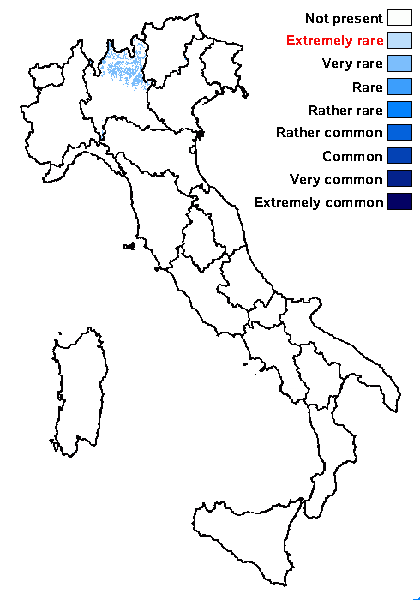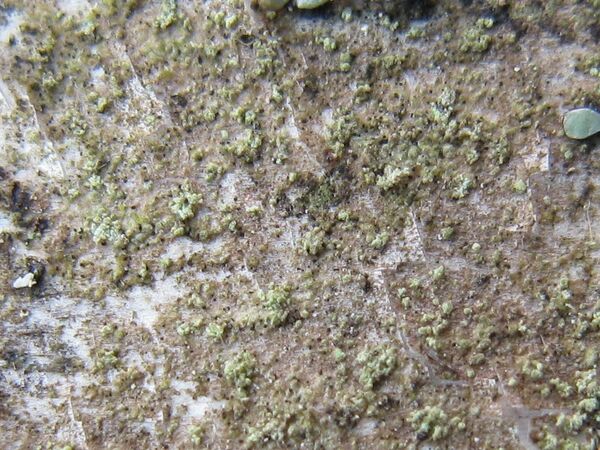Fuscidea pusilla Tønsberg
Sommerfeltia, 14: 138, 1992.
Synonyms:
Distribution: N - Lomb (UPS-L-166764).
Description: Thallus crustose, episubstratic, usually poorly developed, grey-green to green, forming orbicular, up to 1(-2) cm wide patches, often delimited by a brown prothallus; areoles granulose, developing on a brown hypothallus, convex, 0.08-0.16 mm wide, the central ones sorediate; soralia green to pale yellowish with a brown tinge, bursting from the apices of areoles, becoming confluent; soredia mostly farinose 10-15 μm in diam., often aggregated into larger (35-45 μm) consoredia. Apothecia extremely rare (not observed in Italian material), according to Zahradníková (2018) lecideine, sessile and constricted at base, rounded, up to 0.9 mm across, dark grey-brown to black, with a flat to rarely slightly convex, usually black disc, and a paler or concolorous, flexuose proper margin. Epithecium brown; hymenium brownish, to 100 μm high; paraphyses 1.5-3 μm thick at mid-level, the apical cells brown, to 6 μm wide; hypothecium colourless. Asci 8-spored, clavate, with a thin external and internal K/I+ dark blue cap surrounded by a thick K/I+ pale blue apical cap, and with a K/I- apical tube in tholus, Fuscidea-type. Ascospores 1-celled, hyaline, ellipsoid and slightly constricted in the middle, 6-10 x 2.5-4.5 μm. Photobiont chlorococcoid. Spot tests: thallus K-, C-, KC-, P-; soralia UV+ blue-white. Chemistry: divaricatic acid.Note: a widespread holarctic species found on the bark of (mostly) conifers in humid montane to subalpine forests (Zahradníková & al. 2018); several records of F. lightfootii from the Alps (outside Italian territory) could prove to refer to this species, which is hardly distinguishable from F. lighfootii without mnolecular data. The Italian sample was collected by G. Thor in the Adamello National Park.
Growth form: Crustose
Substrata: bark
Photobiont: green algae other than Trentepohlia
Reproductive strategy: mainly asexual, by soredia, or soredia-like structures (e.g. blastidia)
Commonnes-rarity: (info)
Alpine belt: absent
Subalpine belt: very rare
Oromediterranean belt: very rare
Montane belt: very rare
Submediterranean belt: absent
Padanian area: absent
Humid submediterranean belt: absent
Humid mediterranean belt: absent
Dry mediterranean belt: absent

Predictive model
Growth form: Crustose
Substrata: bark
Photobiont: green algae other than Trentepohlia
Reproductive strategy: mainly asexual, by soredia, or soredia-like structures (e.g. blastidia)
Commonnes-rarity: (info)
Alpine belt: absent
Subalpine belt: very rare
Oromediterranean belt: very rare
Montane belt: very rare
Submediterranean belt: absent
Padanian area: absent
Humid submediterranean belt: absent
Humid mediterranean belt: absent
Dry mediterranean belt: absent

Predictive model
 Index Fungorum
Index Fungorum
 GBIF
GBIF


